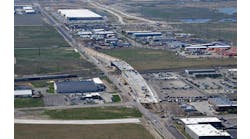By William Parent, Contributing Author
Comprised of 18 overcrossing bridge replacements, an entirely new connector bridge and other bridge modifications, the I-405 Improvement Project in Orange County, California, represents one of the largest and most significant recent roadway and bridge projects in the Western United States.
As the $2.08 billion project enters its final stretch, all remaining bridges are slated to be substantially complete and open to the public by the end of 2023.
The Orange County Transportation Authority (OCTA), in cooperation with the California Department of Transportation (Caltrans), is improving 16 miles of the San Diego Freeway (I-405) between State Route 73 (SR-73) and Interstate 605.
In addition to the replacement of corridor bridges, the project – which started construction in 2018 – will also add the 405 Express Lanes from SR-73 to I-605. The new tolled express lanes facility will be two lanes in each direction.
Serving OCTA – OC 405 Partners, the joint venture comprised of OHLA USA and Astaldi Construction, along with its design team members, Lochner, Moffat & Nichol, and Arup – have safely opened 11 overcrossing bridges on the project to date. Three bridges are currently under partial construction with traffic maintained and four bridges are left to fully reopen. In addition, multiple I-405 bridges have been completed for the undercrossing of major arterials, flood channels, and railways.
The design-build project delivery method has allowed for a fast-tracked process, and through collaboration and partnering, has fostered successful results on this signature contract.
The project corridor spans through six individual municipalities, so the bridge aesthetics were tailored to the unique characteristics of the individual cities. The bridge design then ties the project together with uniform barriers, monuments, fencing, and lighting.
The bridge columns also follow a uniform rectangular design, with a stacked block appearance and a fractured limestone pattern. The abutments and wing walls follow the design of the columns, with the same form linear pattern and concrete texture. Sixteen locations feature bridge monuments, which will include specific artwork and community identifiers depending on the city. Monuments are placed where the bridge fencing stops, leaving four of the decorative markers at the overcrossing and two at each undercrossing.
“While bridges had similar design traits, each bridge was unique with its own set of challenges,” said Alex Medyn, OHLA West Region, executive vice president. “It was a remarkable accomplishment to design and construct that many bridges in that timeframe. The final products are abundantly clear on the corridor today.”
As design plans were released for construction, the bridge erection sequence involved careful planning to minimize disruptions to traffic and maximize the schedule efficiency.
Iteris Inc. provided expert traffic management using cutting-edge technology that utilized historical data and real-time traffic monitoring. Through close coordination with Caltrans and corridor cities staff, the team successfully mitigated delays and improved detours during construction. Multiple bridges through the project area have been under construction without major delays on local street networks since 2018.
This project has required that the traffic management and construction teams coordinate daily. As construction managers looked to make strides in the schedule, they relied heavily on the project’s traffic management team to support innovative methods and schedule improvements.
The bridge construction methods on this project include one-stage and two-stage construction sequences. One-stage bridges were demolished all at once, detours were installed for the local traffic, and the bridge was reconstructed in one stage. Two-stage bridges involved demolishing one half of the bridge with traffic maintained on the opposite half. That sequence is then repeated until the full bridge is built in the two stages.
To improve the project schedule, OC 405 Partners proposed to convert multiple two-stage bridges to one stage. This schedule strategy ultimately proved successful and has helped bridges open earlier than anticipated and mitigate delays to the overall project. These changes in construction sequence involved major traffic studies, review of project environmental documents, and significant community outreach to explain the benefits to the public and to the corridor cities, for each individual bridge prior to the start of demolition and reconstruction.
The controlled bridge demolitions were major operations. Strategic and safe construction planning, traffic management, and effective public outreach all played a role in the success of each individual demolition. The construction process involved mobilizing multiple excavators with breaker attachments, the placement of pavement protection for the freeway, plus the handling and hauling of material as needed. Superintendents, safety managers, and staff conducted multiple crews during nighttime closures of the freeway and reopen the freeway to traffic within allowable timeframes.
Since most superstructures spanned over I-405, demolition would require full closures of the freeway in both directions. Weekend closures would typically start at 10 p.m. and continue into the following morning sometimes as late as 10 A.M.
As I-405 is one of the busiest interstates in the country, this extended 12-hour closure duration was only permitted on weekends, when traffic volumes are lowest. Nighttime bridge demolitions under full closures were completed with zero lost time injuries through the life of the project.
“Bridge demolitions had some of our highest public and risk exposures for crews,” said Conrad Lopez, OC 405 Partners, safety director. “The ability to implement major freeway closures, with the assistance of our partners with Caltrans and California Highway Patrol, gave us great confidence. The safety culture was instilled in our crews, and that was especially evident during demolition.”
Bridge demolitions were accompanied by sophisticated public outreach campaigns. OCTA would broadcast the activity, schedule, and closures with far-reaching public outreach through the region, and targeted outreach to local communities. At the outset of the project, local communities took great interest in the demolitions.
During the 2018 Slater Avenue bridge demolition in Fountain Valley, multiple residents gathered at local streets and a park to observe from a safe distance. The flow of information was aided by strong partnerships with local civic entities, first responders, corridor cities, and other local and statewide agencies. The outreach team found a formula for success and repeated that process over the course of multiple years as bridges have continued to be removed and replaced.
Different construction methods were then utilized to reconstruct each individual bridge. Bridges were both self-performed by OC 405 on the project, and sub-contracted to MCM Constructors Inc. Most bridges on the project were cast-in-place, which involved setting and removing falsework and forms over I-405. The installation and removal of falsework over I-405 also required full directional closures of the freeway at night during off-peak hours allowed by Caltrans.
In addition to the cast-in-place method, four bridges – the Bolsa Chica Avenue overcrossing, Ward Street overcrossing, Fairview Road overcrossing, and Euclid Street undercrossing – utilized a pre-cast concrete girder design. Girders were chosen to meet vertical clearance requirements on I-405 and local streets, to avoid issues with meeting the 15’ standard that would have occurred with a falsework structure.
Two of the unique bridges on the project are the Heil Avenue pedestrian bridge and the I-405/SR-73 HOV connector bridge.
The Heil Avenue pedestrian bridge is an existing structure, crossing over I-405 between the cities of Westminster and Huntington Beach that OC 405 Partners replaced as part of the project. While this bridge entailed similar construction methods as other bridges on the project, the span has unique elements, such as vinyl-coated, tube-like fencing that traverses over and protects the walkway, and pedestrian lighting installed within the steel handrails that illuminates the bridge at night. This bridge, fully equipped with the latest ADA standards, serves as a key connection for the local communities, for both pedestrians and cyclists to safely cross the freeway.
Just south in Costa Mesa, crews have erected an entirely new structure in the I-405/SR-73 HOV connector bridge. This bridge will provide the connection for the 405 Express Lanes, two lanes in each direction, between I-405 and SR-73, and is planned to be complete in mid-2023. The stem and soffit and bridge deck were split into multiple concrete placements, totaling over 7,000 cubic yards of concrete. This was the largest bridge on the project in terms of size and scope and represents a gateway to the project corridor.
From the planning phases with inclusive public engagement, to this stage near the finish line, the project has overcome many challenges. The schedule remained on track through the dire consequences of the COVID-19 pandemic. Years of coordination with project partners kept traffic flowing through the corridor through consistent, major closures. The result will be a legacy of bridges and transportation infrastructure in Orange County for the 21st century. R&B
William Parent has worked for nearly a decade in Southern California on multiple transportation megaprojects in the construction industry. He recently relocated to Boston where he will continue on the same career path.




